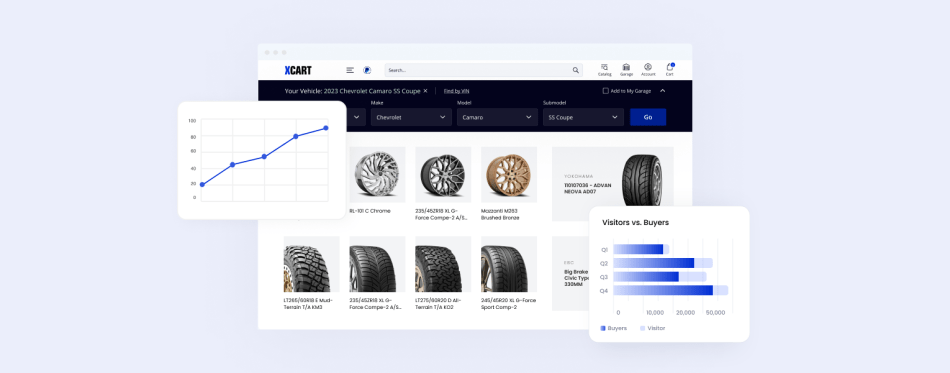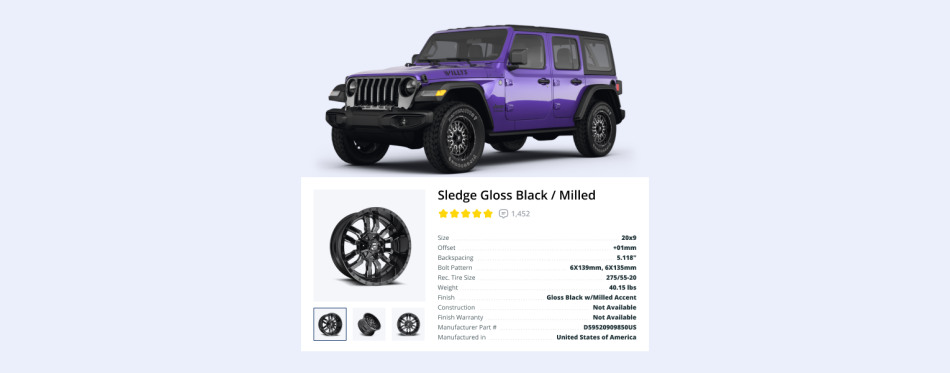7 Proven Strategies to Skyrocket Your Auto Parts Sales
Launching or growing an online auto parts store presents exciting opportunities in today’s booming automotive parts eCommerce market. However, fierce competition from major retailers like O’Reilly’s, AutoZone, and Amazon requires you to adopt diverse and creative promotion strategies to stand out, attract your target audience, and drive sales growth.
In this comprehensive guide, we’ll explore seven effective tactics to successfully market your eCommerce auto parts business, increase visibility, and position your brand as the ultimate destination for online auto part purchases.
Transitioning Your Automotive Aftermarket Business Online
In today’s digital landscape, it is necessary for companies in the automotive aftermarket industry to establish an online presence. Relying solely on a brick-and-mortar retail store means missing out on a large pool of potential customers who increasingly research and purchase auto parts online.
Prioritize the launch of an automotive eCommerce website as well as joining major online marketplace platforms such as Amazon. Enabling customers to conveniently buy inventory digitally, while showcasing your auto parts selection to larger audiences, are critical steps to drive growth. Robust eCommerce engines empower businesses to comprehensively list products, process orders, and fulfill shipments online.
Embracing automotive aftermarket eCommerce is not just about convenience, but also about cost-effectiveness. By transitioning to an online business model, you can reduce the operational expenses associated with maintaining physical retail spaces. This means saving on rent, utilities, staffing, and various other overhead costs that can eat into your profits.
However, selecting the right eCommerce platform is crucial. It should align seamlessly with your business objectives and budget. A robust eCommerce engine empowers businesses to comprehensively list products, process orders efficiently, and ensure seamless order fulfillment. When choosing a platform, carefully consider factors such as customization options, scalability, security features, and user-friendliness.
1. What is SEO Marketing?
With the rise of eCommerce, the auto parts purchasing journey for most consumers starts on Google and other search engines. If potential customers can’t easily find your website and products through a search, you’ll miss out on traffic and sales opportunities. That’s why search engine optimization (SEO) needs to be a central focus of your digital marketing efforts. Failing to appear prominently in search results can mean missed opportunities and lost sales.
Here are key factors to focus your SEO efforts on:
- Conduct Extensive Keyword Research: Brainstorm and research the main keywords and long-tail key phrases people are using to search for auto parts online. Look at search volume and competition to identify opportunities to target more niche terms. Tools like Google Keyword Planner, SEMrush, and Moz Keyword Explorer can help uncover this data.
- Optimize Website Content: Incorporate your target keywords naturally throughout your site content and product descriptions. Create blog posts and guides optimized for keywords around trending parts, DIY repairs, maintenance tips, and industry news. Ensure your headlines, URLs, metadata, and alt text are SEO-friendly.
- Improve Site Architecture: Structure your site architecture and internal links to make it easy for search engines to crawl and index your pages. Enable breadcrumbs and site maps. Optimize page load speeds. Include schema markup to help search engines understand your content.
- Build Authoritative Backlinks: Earn backlinks from authority websites and directories like Cars.com, Kelley Blue Book, RepairPal, and NAPA AutoCare to improve domain authority. Create shareable content that sites will be motivated to link back to. Guest post on niche blogs and partners with complements.
- Analyze Your SEO Performance: Use Google Search Console, Google Analytics, and tools like Moz, SEMrush, and Ahrefs to analyze your organic traffic sources, rankings, and metrics. Identify areas for improvement. Produce monthly reports to track your progress.
By dedicating time and resources each month to execute these SEO fundamentals, your eCommerce site visibility will gradually improve. As you rank higher in organic search, you earn more qualified traffic from consumers actively looking for auto parts online. SEO delivers long-term rewards.
2. How To Develop A Content Marketing Strategy
Creating and maintaining a high-quality blog should be at the heart of your digital marketing plans. Not only does valuable content attract organic search traffic, but it also plays a pivotal role in building brand awareness and establishing domain authority.
Before delving into content creation, it’s essential to define the goals you aim to achieve with your blog content. Whether it’s driving traffic, increasing social engagement, or capturing more newsletter sign-ups, a clear understanding of your content’s purpose will help you determine what type of content will resonate most effectively with your audience.
Leveraging keyword research is an invaluable strategy to identify topics and long-tail keywords that align with what your target audience is searching for in relation to your auto parts inventory. Keyword research not only guides your content but also enhances website visibility, as search engines are more likely to rank content that addresses relevant search queries.
To maintain consistency and structure in your content creation efforts, consider plotting out your content roadmap on an editorial calendar. A well-structured editorial calendar ensures that you maintain a steady flow of content that addresses your audience’s needs and interests. It also allows you to plan content around seasonal trends, product launches, and promotional campaigns, maximizing the impact of your content strategy.
In addition to blog posts, consider creating other types of content that can resonate with your audience, such as video tutorials, infographics, and podcasts. These formats not only diversify your content offerings but also cater to different learning and consumption preferences among your target audience.
As you develop your content strategy, remember that quality always trumps quantity. While it’s important to maintain consistency in publishing, ensure that each piece of content you create is well-researched, well-written, and provides genuine value to your audience.
3. Using Ads to Get Noticed
While SEO is a powerful long-term strategy, it often takes time to see significant results. Paid advertising, on the other hand, allows you to position your eCommerce store directly in front of potential customers actively searching for auto parts online.
To maximize the effectiveness of your paid advertising campaigns, consider leveraging the following key ads:
- Google Shopping Campaigns: One of the most effective ways to showcase your products to potential customers is by setting up product listing ads in the Google Shopping Network. These ads display your products in search results and on partner shopping sites whenever users search for relevant auto parts terms. An advantage of this approach is that you only pay when users click on your ads. To make the most of Google Shopping Campaigns, optimize your product data feed and bidding strategy for maximum visibility and ROI.
- Search Retargeting Ads: Use Google and Bing remarketing ads to keep your brand top-of-mind with visitors after they leave your site. Displaying relevant ads across search engines boosts brand awareness and the likelihood of conversions.
- Facebook and Instagram Ads: Social media platforms like Facebook and Instagram offer highly targeted advertising options that allow you to reach auto enthusiasts in your specific geographic area. By testing different audience segments, ad placements, and content types, you can fine-tune your advertising efforts to achieve the best cost per conversion.
- YouTube Video Ads: Video content is immensely popular, especially among auto enthusiasts seeking DIY repair tutorials and auto maintenance tips. Producing engaging video ads that resonate with your target audience can help you engage potential customers through visual content. By promoting these videos on YouTube, you can effectively tap into the vast audience of auto enthusiasts on the platform.
- Display Banner Ads: Don’t underestimate the power of display advertising. By utilizing the Google Display Network, native ads, and targeted placements on niche auto blogs and forums, you can increase your brand’s visibility significantly. Banner ads, when designed effectively, can capture attention and drive traffic to your eCommerce site.
The key to successful paid advertising is continuous testing and optimization. Regularly review your campaigns and make adjustments based on the key performance indicators (KPIs) that matter most to your business.
To ensure an optimal return on investment, consider limiting your audience to local markets or specific demographics that align with your target customer profile. In some cases, testing small daily budgets on high-value promotions can yield significant returns in terms of conversions.
4. The Importance of Optimizing a Website
Your website serves as the digital storefront for your auto parts eCommerce business, and its search engine optimization and user-friendliness are critical factors for attracting and retaining customers.
A search engine-optimized website ensures that search engines can crawl, index, and understand your site’s content effectively. This results in better search engine rankings and visibility. Moreover, user-friendly websites enhance the overall experience for visitors, making it more likely that they’ll convert into customers.
Ensure your website meets the following criteria for effective optimization:
- Easy Navigation: A user-friendly navigation structure is essential. Ensure that visitors can easily find the products they’re looking for without getting lost in a complex web of pages. Well-organized menus, clear categories, and intuitive search functionality all contribute to smooth navigation.
- Mobile Responsiveness: With the growing prevalence of mobile device usage, your website must be responsive to different screen sizes. A mobile-responsive design ensures that your site functions smoothly and looks appealing on smartphones and tablets.
- Page Load Speed: Slow-loading pages drive visitors away. Page load speeds under 2 seconds reduce bounce rates and increase conversion rates. This can be achieved by optimizing images, leveraging browser caching, and employing content delivery networks (CDNs).
- Security Features: Ensuring the security of your customers’ data is paramount. Implement SSL (Secure Sockets Layer) encryption to protect sensitive information, such as payment details. Displaying trust badges and security icons on your site can also boost visitor confidence.
- User Experience (UX) Design: Pay attention to the overall design and layout of your website. A well-designed site should be visually appealing, easy to read, and free from distracting elements that could deter customers from completing their purchases.
- Clear Call to Action (CTAs): Make it obvious what you want your visitors to do next. Whether it’s adding a product to their cart, signing up for a newsletter, or contacting your support team, your CTAs should be clear and strategically placed.
By investing in the optimization of your website, you create a digital storefront that not only attracts visitors but also provides them with a seamless and enjoyable shopping experience.
5. What is User-Generated Content?
Online shoppers heavily rely on social proof and peer recommendations when making purchase decisions. According to Statista, user-generated content directly increases eCommerce conversions by at least 3.2%. Therefore, actively cultivating reviews, testimonials, and user-generated content (UGC) can be a game-changer for your auto parts eCommerce business.
- Product Reviews: Make it effortless for customers to leave detailed reviews about their experience ordering from your store and provide feedback on the parts they purchased. Consider implementing a rating system and encourage customers to leave honest reviews about product quality, shipping speed, and customer service. Showcase these reviews prominently on each product page. Positive reviews instill confidence in potential buyers, while negative ones offer transparency and an opportunity to address issues.
- User Photos/Videos: Encourage customers to share photos and videos of the parts they purchased from your store installed on their vehicles or projects. This content can be integrated across your website, prominently featured on product pages, and shared on your social media channels. Showcasing the best user-generated images and videos prominently on product pages can offer potential buyers a clear picture of what they can expect.
- Case Studies: Develop written and video case studies that delve into the experiences of customers who have successfully built cars or completed repairs using parts from your store. Highlight the specific products purchased and the impressive results achieved. Case studies add depth to your brand’s narrative and serve as persuasive pieces of content that showcase your products’ real-world applications.
6. The Importance of Accurate and Up-to-Date Vehicle Fitment Data
In the auto parts industry, maintaining accurate and up-to-date fitment data should be a top priority. By investing time and resources into ensuring your fitment data is precise, you not only enhance the customer experience on your website but also position your auto parts business as a reliable source of information and products.
When customers shop for parts online, they rely on fitment specifications to determine if a product will properly fit their specific vehicle. Nothing is more frustrating than ordering a part just to find out it doesn’t actually fit your car or truck. Providing inaccurate or outdated fitment data erodes customer trust and leads to returns and negative reviews.
Maintaining precise fitment data is crucial for several reasons:
- Customer Trust and Confidence: When customers visit your online auto parts store, they want assurance that they are making the right choice. Accurate fitment data builds trust and confidence. It assures customers that they are purchasing the correct parts, eliminating the frustration of buying something incompatible.
- Reduced Returns and Errors: Accurate fitment data significantly reduces the likelihood of customers ordering the wrong parts. This, in turn, leads to fewer returns and reduces the operational costs associated with handling returns and processing refunds.
- Enhanced Searchability: Properly maintained fitment data makes it easier for customers to navigate your website or eCommerce platform. With the right filters and search options, customers can quickly filter parts based on their vehicle’s specifications, saving time and improving the overall shopping experience.
7. Optimizing the Checkout Process
The checkout process is one of the most important aspects of running an auto parts eCommerce store. It’s the last step in the customer journey, and if it’s not optimized, you risk losing a sale.
Here are some essential strategies to enhance this critical phase:
- Keep it Simple and User-Friendly: Make sure the process is simple and easy to understand. Here’s how to achieve that:
- Minimal Steps: Reduce the number of steps required to complete a purchase. The more steps involved, the higher the chance of cart abandonment.
- Guest Checkout: Offer a guest checkout option so that customers can buy without creating an account. Many shoppers prefer this streamlined approach.
- Clear Forms: Ensure that form fields are easy to understand and complete. Use auto-fill options wherever possible to save customers time.
- Error Handling: Provide instant feedback if there are errors in the form, and clearly explain how to correct them.
- Use Clear Call-to-Actions (CTAs): Useprominent CTAs to motivate customers to complete their purchases. Clear and persuasive CTAs are essential:
- Prominent Buttons: Use visually distinct buttons for actions like “Proceed to Checkout,” “Place Order,” and “Continue Shopping.”
- Progress Indicator: Display a progress bar or step-by-step guide to inform customers about where they are in the checkout process.
- Trust Seals: Display security badges and trust symbols to reassure customers that their payment information is safe.
- Offer Multiple Payment Options: Customers have varying payment preferences, so providing a range of payment options can boost conversion rates:
- Credit Cards: Accept major credit cards like Visa, MasterCard, and American Express.
- Digital Wallets: Include options like PayPal, Apple Pay, Google Pay, and Amazon Pay.
- Alternative Methods: Consider adding Buy Now, Pay Later options like Afterpay or Klarna.
- Provide Progress Indicators: Add progress indicators that show customers their progress through the checkout funnel. This provides a sense of re-assurance they are on the right track:
- Number Steps: Label each step in the process (e.g., Step 1: Review Cart, Step 2: Shipping Info) so customers know where they are.
- Visual Cues: Use visual icons or checkmarks to show completed and remaining steps.
Final Thoughts
As the automotive aftermarket industry continues shifting online, partnering with the right eCommerce experts can provide businesses with a distinct competitive edge. That’s where Integreat Commerce and X-Cart come into play.
Integreat Commerce offers specialized eCommerce services tailored for the automotive aftermarket. Integreat can perfect paid ads, SEO, site speed, plug-ins, navigation, and UX to boost conversions through website optimization services. They also offer seamless platform migration services to transition auto parts sites to new platforms like X-Cart. Integreat Commerce knows how to connect your business with the right audience and boost website optimization and conversions in the competitive automotive parts landscape.
X-Cart is a trusted eCommerce platform that empowers businesses to create and manage online stores efficiently. Its features and flexibility make it an ideal choice for auto parts retailers looking to establish a robust online presence.
The partnership between X-Cart and Integreat Commerce offers seamless integration of a powerful eCommerce platform with expert digital marketing, platform optimization, and migration services. This collaboration ensures that your auto parts store not only has a compelling online storefront but also receives the strategic guidance needed to excel in the digital marketplace. Partner with Integreat Commerce and leverage the capabilities of X-Cart to drive your eCommerce success.
About the author









